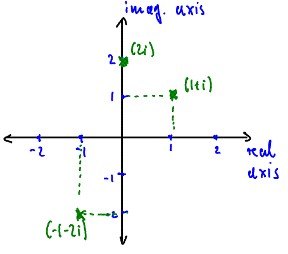Physicist: Yes, but they don’t fix problems the way the complex numbers do.
The nice thing about real numbers (which includes basically every number you might think of: 0, 1, π, -5/2, …) is that no matter how you add, subtract, multiply, or divide (other than 0) them together, you always get another real number. This property is called being “closed”. A mathematician would say “the real numbers are closed under addition, because any real numbers added together always give you another real number”.
Closed-ness is comforting to have, because it means that when you’re doing basic math, no matter how you jump you’ll always have somewhere to land. Mathematically speaking.
However! When you’re doing square roots the real numbers are not closed. When you ask “” what you mean is “
“. For example, to find
, you just answer the question,
, and find that the answers are ? = 2 or -2. But if you try the same thing with
you’ll be trying to answer the question
, which doesn’t have any answers (try it). To “solve” this problem Euler decided to make up a new “number” called “
“, with the property that
, and complex numbers were born.

Every complex number can be written “A+Bi”, where A and B are regular numbers. Notice that when B=0 you’ve got a regular, real number, so the complex numbers include the real numbers.
So here’s where the question comes into play. may patch the problem with
, but does it just give rise to a new problem when you try to figure out what
is? Turns out: no!
You can check this by squaring it:
Weirdly enough, there is absolutely no combination of roots/exponentiations or multiplications/divisions or additions/subtractions that can break out of complex numbers. Where the closed-ness of real numbers fail, complex numbers hold strong. This is one of the important aspects of the “fundamental theorem of algebra“. You can tell mathematicians think it’s important, they don’t call just anything the “fundamental theorem of whatever”.
Finally, here’s the answer, there are a lot of (infinite) number-systems bigger than the complex numbers that contain the complex numbers in the same way that complex numbers contain the real numbers. However, they’re not “needed”.
The smallest number system that’s bigger than the complex numbers is the “quaternions”. The real numbers can be built from “1” and then seeing what you can get from any combination of adds, multiplies, etc. (and then filling in the gaps). Complex numbers can be built the same way, starting with “1” and “i”. Quaternions are built out of 1, i, j, and k. i, j, and k all do basically the same thing that i does in complex numbers; . In addition, ij=k, jk=i, ki=j, and if you flip the order you flip the sign, so ji=-k.
Quaternions don’t “patch holes” that the complex numbers have, but they do help with some very complicated problems that other number-systems can’t handle easily. To head off the next obvious question; yes, there are even larger number-systems, like the “octonians“, and inventing ever higher systems is easy enough.
The graph is a picture from here.







Pingback: Is the set of all distinct mathematical number types countable? - MathHub